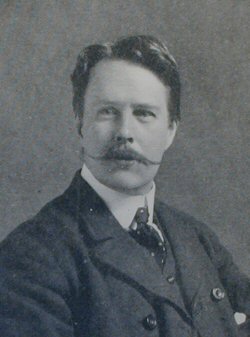 NEIL
MUNRO
NEIL
MUNROWHEN "The Lost Pibroch and other Sheiling Stories" first appeared in 1896, the book was at once recognised as a new voice in literature - the long-suppressed genius of the Gaelic race finding forceful expression in English romance - and people spoke of a new "Celtic movement," "Celtic revival," and the like. Since then Mr. Neil Munro has produced book after book, and he has not disappointed the prophets.
A descendant of shepherds and farmers in Glenaray, the novelist was born in Inveraray in 1864. He learned his lessons for the parish school by the light of a cruisie fed with herring oil; and while he swam in the loch, fished the streams, and climbed the hills of the region, the little "Highland capital" was still full of old clan stories, which were to be turned to account at a later day in the novelist's romance. At seventeen he entered a lawyer's office in his native town, but already the spell of the story-teller was upon him, and he sent contributions to the county papers. Then he determined to adopt journalism as a profession, and by dint of a copy of the "Reporter's Companion" taught himself the art of shorthand writing. At the age of twenty-one he became a reporter on the Greenock Advertiser, from which he moved presently to the staff of the Glasgow News. For a time he went to the Falkirk Herald, but returned to the News, and on the death of that paper in 1888, he became chief reporter under Mr. Murray Smith on the Evening News. From that post he was promoted successively to be a sub-editor, and to be assistant editor, art critic, and reviewer. In 1893 he began to write his "Lost Pibroch" stories, drawing on his memories and impressions of Inveraray and Old Argyll. "The Secret of the Heather Ale" appeared in The Speaker, "Red Hand," in Mr. Henley's paper, the National Observer, and "Shudderman Soldier" in Blackwood's Magazine. After the publication of the collected series in "The Lost Pibroch" he began his first serial, "John Splendid" in the pages of Blackwood. This was followed by "Gilian the Dreamer" in Good Words, and since then have come "Doom Castle," "The Shoes of Fortune," "Children of Tempest," and "The Daft Days." In 1907 Mr. Munro produced a volume on "The Clyde River and Firth," for Messrs. A. & C. Black's "Beautiful Books on Scotland" series. Meanwhile Mr. Munro found it advisable to give up the greater part of his work on the Evening News, and removed out of town to the romantic neighbourhood of Waterfoot on the Cart, under the Eaglesham moors. He did not altogether burn his boats, however, but continued his journalistic connection by writing special articles for the Evening News. There are few in Glasgow who do not make a point of enjoying "The Looker-On" and "Views and Reviews" in the columns of that paper, and in 1903 he struck a new and happy vein with his articles containing the wit and wisdom of "Erchie" the Glasgow beadle, which in volume form became the catch of the bookstalls in 1904. This venture he followed with another delightful production in the same vein, "The Vital Spark," in 1905, which proved still more popular and successful.
For the sake of his children's education Mr. Munro has recently lived in Gourock, whence, every summer morning he sees the Lord of the Isles beat away down the firth for the far "Inneraora" and the vistas of Shira Glen. The novelist is a popular member of the Institute of Journalists and of the Glasgow Ballad Club; for he is a poet with the wistful charm of the Highlands in his song. He is still young and there are new worlds of romance to enter. Meanwhile success has not spoiled Neil Munro. and no one grudges him his success. In April, 1908, Glasgow University conferred upon Mr. Munro the honorary degree of LL.D., and in May, 1909, he was presented with the freedom of his native town, Inveraray.